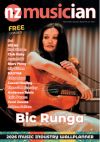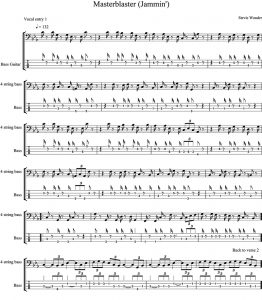Deep Thinking: Stevie Wonder’s Masterblaster (Jammin’)
Deep Thinking: Stevie Wonder’s Masterblaster (Jammin’)
I always used to say to bass students in the UK and here that two of Stevie Wonder’s most challenging bass lines are from Sir Duke, with its Duke Ellington inspired line doubling the brass, and Masterblaster (Jammin’) from the 1980 album ‘Hotter Than July’. The bass line is doubled on keyboards and played by Stevie’s long-time bassist, Nathan Watts.
We are going to play a section from Masterblaster, which looks tough when notated but is mainly built from various inversions of triads. As a reminder, triads are three note chords with the notes in various orders (root, third, fifth, or third, fifth root, or fifth, root, third). The tune is in C natural minor so, apart from a couple of notes outside the key, all of the notes are from C,D,Eb,F,G,Ab,Bb,C. The shuffle rhythm is almost constant and was one of the first reggae hits in the US.
This transcription starts at the first vocal entry and continues to the first chorus and the riff that follows it. The first eight bars follow a Cminor, Bb, Ab, Ab, F, F, Cminor, Cminor chord sequence with the use of the triads in various inversions mentioned above. The second half of the verse has a quaver (eighth note) triplet in the Ab bar (bar 11). There is another one in the Fmajor bar (bar 13).
The end of bar 16 has a B# as a passing note into the chorus, which has a sequence of Cminor, G, Fminor, G before a string of triplets, all of which are more or less chord inversions and can be played with notes played by your little finger on fret 6, string 4 (or finger 1 on string 3) and finger 1 moving between Bb and F on strings 3 and 2 (listen to it on YouTube and/or follow the TAB). You then return to the second verse (same as verse 1 but with a couple of variations).
This is followed by another chorus and a longer, more difficult sequence of triplets that, due to space, we’ll leave for another day. I always find it interesting that reggae was popularised in the US by this track and by Eric Clapton even though Marley later became a superstar there.
Dr. Rob Burns is an Honorary Associate Professor in Music at the University of Otago in Dunedin. As a former professional studio bassist in the UK, he performed and recorded with David Gilmour, Pete Townsend, Jerry Donahue, Isaac Hayes, James Burton, Ian Paice and Jon Lord, Eric Burdon and members of Abba. Rob is currently a member of Dunedin band, The Verlaines and is on three new progressive rock albums released in the UK in 2020 and 2021. There is a further album available on Seelie Court Records (UK) that Rob played on when he was 16.) with a second one released in December 2021. A live album from his teens in the 1970s was released in May 2022 and is now available on vinyl.

